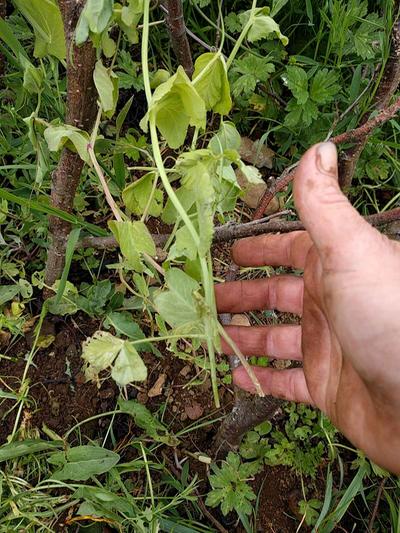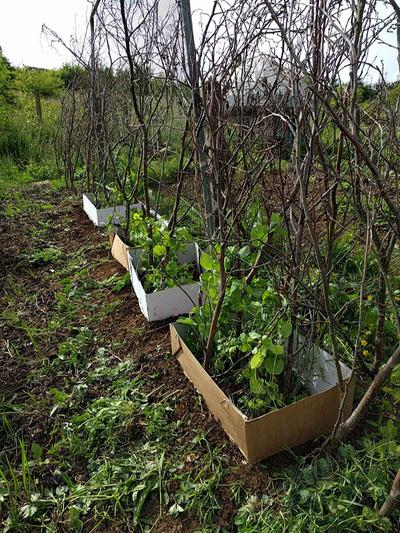
 4
4




 17
17




 19
19




 8
8




 17
17




 6
6




 9
9




Invasive plants are Earth's way of insisting we notice her medicines. Stephen Herrod Buhner
Everyone learns what works by learning what doesn't work. Stephen Herrod Buhner
 7
7




Forever creating a permaculture paradise!

 4
4




 . I've put up a tall perch to encourage local raptors to pop in for a snack. The dogs are worse than the voles for crop damage! So they are fenced out. I did find a short cardboard fence was remarkably effective at stopping the voles nipping through my pea stems - plastic vole guards were effective to protect my young trees, so it seemed worth a try. Voles can't climb well (unlike mice). I'm going to try polyculture - mixing my peas and fava beans up to see if that helps the peas survive this year.
. I've put up a tall perch to encourage local raptors to pop in for a snack. The dogs are worse than the voles for crop damage! So they are fenced out. I did find a short cardboard fence was remarkably effective at stopping the voles nipping through my pea stems - plastic vole guards were effective to protect my young trees, so it seemed worth a try. Voles can't climb well (unlike mice). I'm going to try polyculture - mixing my peas and fava beans up to see if that helps the peas survive this year.How Permies works: https://permies.com/wiki/34193/permies-works-links-threads
My projects on Skye: The tree field, Growing and landracing, perennial polycultures, "Don't dream it - be it! "

 20
20




- Tim's Homestead Journal - Purchase a copy of Building a Better World in Your Backyard - Purchase 6 Decks of Permaculture Cards -
- Purchase 12x Decks of Permaculture Cards - Purchase a copy of the SKIP Book - Purchase 12x copies of Building a Better World in your Backyard
 6
6




 6
6




Country oriented nerd with primary interests in alternate energy in particular solar. Dabble in gardening, trees, cob, soil building and a host of others.
 6
6




 15
15





Perfect The Dwelling Land and support the kickstarter! https://www.kickstarter.com/projects/paulwheaton/garden-cards?ref=90v0pa
 4
4




Nancy Reading wrote:I hadn't heard of using nematodes to get rid of voles....
I'd also like to find a solution. I did find a short cardboard fence was remarkably effective at stopping the voles nipping through my pea stems - plastic vole guards were effective to protect my young trees, so it seemed worth a try. Voles can't climb well (unlike mice). I'm going to try polyculture - mixing my peas and fava beans up to see if that helps the peas survive this year.
 11
11




 6
6




"Draw your own conclusions, but draw them in pencil so you can change them again later."
-- Douglas Black
 8
8




 5
5




 3
3




Samantha Lewis wrote:Voles? These cute little guys?
 5
5




 4
4




 4
4




 5
5
















 2
2




Beth Borchers wrote: Please provide more info on the cardboard fence as in where you bought it and how you use it. And then please keep us informed as to how the peas and fava beans mix works out for you.


How Permies works: https://permies.com/wiki/34193/permies-works-links-threads
My projects on Skye: The tree field, Growing and landracing, perennial polycultures, "Don't dream it - be it! "
 4
4




Nina Wright wrote:Physical Barrier: https://staliteenvironmental.com/vole-control-1
apparently is sharpish rocks that voles don't like to dig through. But still needs an overground barrier.
we're hosting guests that are interested in the topics we're working on
 3
3




Finished 2 life quests (well... almost). Wondering what to do next? Zone 5b
 7
7




 3
3




Each generation has its own rendezvous with the land... by choice or by default we will carve out a land legacy for our heirs. (Stewart Udall)
 9
9




Real funny, Scotty, now beam down my clothes!
 6
6




Cole Tyler wrote:My dog gets at least a dozen a year (mostly young/babies) she has great hearing and smell. It's a little rough on the gardens tho when she digs.
 3
3




 9
9




 4
4




Maybe Life is always like being on a trapeze or a tightrope at the circus...
 4
4




 3
3




De-fund the Mosquito Police!
Become extra-civilized...




Steph Schmidtmeyer wrote:
Tommy Bolin wrote:
Snowy owls can hear them under the snow from a silent hover. That feathered, round facial disk focuses sound to their ultra sharp ears. Dive/pounce.
 7
7





|
You learn how to close your eyes and tell yourself "this just isn't really happening to me." Tiny ad:
The new gardening playing cards kickstarter is now live!
https://www.kickstarter.com/projects/paulwheaton/garden-cards
|






